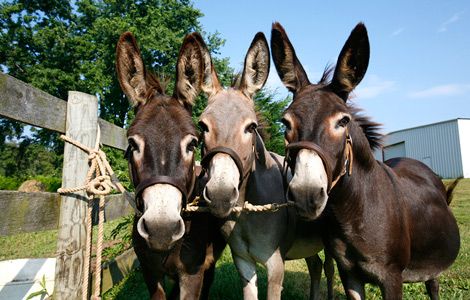Donkey Cuisine in Italy
 Sunday, October 13, 2013 at 1:10PM
Sunday, October 13, 2013 at 1:10PM They eat donkeys in Italy. While we were in Mantua we were told it was a local specialty in the restaurant where my husband ordered kangaroo for lunch. Donkey stew was there on the menu with the kangaroo steak and I confess, I had never seen either on any menu, not even in New Zealand where it is geographically closer to kangaroos than Italy.
A shiver of revulsion ran up my spine as I ordered the beef with seasonal mushrooms and prepared myself for the medium rare kangaroo to appear beside me on a plate in front of my husband.
 As we dug into the breadbasket I had a donkey flashback and fondly remembered the family burro we adopted the summer we packed into the High Sierra. The pack station at Kings Canyon National Park in California outfitted us with a donkey to carry our gear because we needed help with the food and camping equipment for two small children and two otherwise sane adults. My daughter Alexandra was nine and she fell deeply in love with the nameless beast of burden that trotted along the trail with us at the end of a frayed lead. He was the topic of endless fascination for her as we inched our way into the wilderness toward Jenny Lake. Her five-year old brother didn’t share her enthusiasm and was more interested in the Gatorade and the M&M’s in the trail mix, as I recall.
As we dug into the breadbasket I had a donkey flashback and fondly remembered the family burro we adopted the summer we packed into the High Sierra. The pack station at Kings Canyon National Park in California outfitted us with a donkey to carry our gear because we needed help with the food and camping equipment for two small children and two otherwise sane adults. My daughter Alexandra was nine and she fell deeply in love with the nameless beast of burden that trotted along the trail with us at the end of a frayed lead. He was the topic of endless fascination for her as we inched our way into the wilderness toward Jenny Lake. Her five-year old brother didn’t share her enthusiasm and was more interested in the Gatorade and the M&M’s in the trail mix, as I recall.
By the time we reached our destination Alexandra had named our companion “Pepper” and had so thoroughly fondled his tail and the fuzzy inside of his ears that she had the pungent smell of donkey on her that more than filled the tent when we zipped in for the night.
The wine arrived at the table and we started on our insalata mista after carefully dressing it with the olive oil and vinegar. My donkey reverie continued as I recalled what a tough night we had that first night on Jenny Lake. We were no wranglers and because our daughter loved Pepper so much we decided to keep him close to the tent and treat him like an extra large dog. He noisily stomped and snorted outside the tent all night and we discovered in the morning that he had been busy making a mess. When we pulled the tent flap back we discovered what looked like a stable before us with flies and donkey droppings everywhere. Horrified, we moved the tent and tethered Pepper about a hundred yards away.
When the kangaroo was served I was surprised it looked and smelled like a delicious entrée. My husband gave me a bite and I grudgingly acknowledged how hungry Australian Bushmen could grow a taste for fuzzy hopping marsupials. It was tender with a full rich taste not unlike beef.
 Donkey StewChewing my succulent beef in mushroom sauce I once again considered donkey stew and had another flashback to the ending of the Sierra adventure with “Pepper.” While he was good at looking furry and dumb it took us until the third day while on the journey out of the wilderness to realize he was a donkey genius. Pepper was a prodigy in the area of torturing inexperienced city slickers who presume to rent pack animals. And I mean torture.
Donkey StewChewing my succulent beef in mushroom sauce I once again considered donkey stew and had another flashback to the ending of the Sierra adventure with “Pepper.” While he was good at looking furry and dumb it took us until the third day while on the journey out of the wilderness to realize he was a donkey genius. Pepper was a prodigy in the area of torturing inexperienced city slickers who presume to rent pack animals. And I mean torture.
At the beginning of our trip when the wrangler easily secured the primitive looking wooden cross piece, called crutches, with ropes under the belly, over the haunches and around the wooden harness it looked easy to replicate. I’m sure my husband thought, “Any cud chewing 49er could do that. It looks easier than tying sailing knots!” We felt confident about getting Pepper, our gear and our children back to civilization in time for dinner and a much needed bath. I remember for first half mile of the hike we were light hearted until it started…the harness slipped and all the gear landed on the ground with a messy thud. Pepper just stood there looking stupid and innocent with the tangle of ropes cascading off his smelly back. We said, “Oh dear,” the first time and repeated the lengthy process of getting Pepper prepared for the trek, giving him a hard punch in the belly to make sure we got the air out of him so it didn’t happen again.
But it did happen again and again and again all day until I cried with frustration and started to worry about darkness. In desperation we agreed the children and I had to go ahead to the pack station so they could send a wrangler to rescue my belagered husband who was thoroughly Pepper’s victim by this time despite the most aggressive kicks in the gut. Pepper was impossible and we were traumatized. I didn’t think of it at the time but if I had known about Italian donkey cuisine I would have renamed Pepper “Stew.”
Hmmm, yes I remember now. That night when I finally got the children to bed I would have happily eaten a bowl of Pepper stew.
Our meal was over and we were finishing the bottle of the local Lambrusco wine that was perfect with lunch. It is low in alcohol and frizzante (sparkling) and went well with the beef and the kangaroo. As I reflected on another fabulous meal in Italy I decided before leaving the Lombardy region I would sample the delights of donkey cuisine in Italy after all. YES, please pass the pepper.
Copyright © 2013 Gayle Madison


